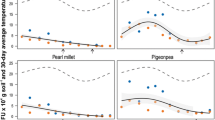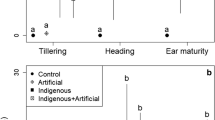Abstract
Health status of winter wheat roots and thecomposition of wheat root fungi were studiedover 1996-1999 following the cultivation ofoats in a pure stand and mixed with otherplants as forecrops. The infection of wheatroots by >Gaeumannomyces graminis wasobserved to be largely dependent on the kind offorecrop; the best being oats in a pure stand,and then oats with pea or lupin mixtures. Inthe emergence and shooting phases, saprophyticfungi were dominant, while in the stage of harddough stage mainly pathogenic fungi, especially>G. graminis were common. The pathogenicfungi were mostly represented by >G.graminis and >Fusarium spp., while >Rhizoctonia spp. were much less frequent.The composition of the fungal communitydepended considerably on the forecrop anddevelopment phase of the plant. The kind offorecrop significantly affected the frequencyof infection by >G. graminis. The highestnumber of isolates was obtained from wheat rootsof crops grown after a mixture of oats andbarley.
Similar content being viewed by others
References
Bateman, G.L. and H. Kwasna, 1999. Effects of number of winter wheat crops grown successively on fungal communities on wheat roots. >Applied Soil Ecology 13: 271–282.
Bateman, G.L., E. Ward, D. Hornby and R.J. Gutteridge, 1997. Comparision of isolates of take-all fungus, >Gaeumannomyces graminis var. >tritici, from different cereal sequences using DNA probes and non-molecular methods. >Soil Biol. Biochem. 29(8): 1225–1232.
Bojarczuk, M. and J. Bojarczuk: 1990. Estimation of the value of forecrops for cereals in phytosanitary aspect, Part III. Response of spring barley to unfavourable soil factors in phytosanitary aspect after different forecrops. >Fragmenta Agronomica 1(25): 5–24.
Carter, J.P., J. Spink J.P.F. Cannon, M.J. Daniels and A.E. Osbourn, 1999. Isolation, characterization, and avenacin sensitivity of a diverse collection of cereal-root-colonizing fungi. >Applied and Environmental Microbiology >65(8): 3364–3372.
Cichy, H., A. Cicha, W. Mackowiak and H. Wos, 1994. Effect of forecrop on infection of winter cereals by foot diseases pathogens. >Genetica Polonica 35 B: 397–403.
Kollmorgen, J.F., J.B. Griffiths and D.N. Walsgott, 1983. The effects of various crops on the survival and carry-over of the wheat take-all fungus >Gaeumannomyces graminis var. >tritici. >Plant Pathology >32: 73–77.
Lemanczyk, G. and A. Lukanowski, 2000. Fungal communities and health status of winter wheat roots cultivated after lupine and its mixtures. >Phytopathologia Polonica 20: 139–154.
Lemanczyk, G. and Cz. Sadowski, 2000. The effect of different forecrops on the occurrence of >Fusarium spp. in winter wheat rhizosphere. >Phytopathologia Polonica 20: 131–138.
Morrissey, J.P. and A.E. Osbourn, 1999. Fungal resistance to plant antibiotics as a mechanism of pathogenesis. >Microbiology and Molecular Biology Reviews 63(3): 708–724.
Osbourn, A.E., B.R. Clarke, P. Lunness, P.R. Scott and M.J. Daniels, 1994. An oat species lacking avenacin is susceptible to infection by >Gaeumannomyces graminis var. >tritici. >Physiol. Mol. Plant Pathol. 45: 457–467.
Plaskowska, E., 1991. Communities of fungi associated with winter wheat manifesting symptoms of the foot-rot complex, cultivated after different forecrops. >Phytopathologia Polonica 1(XIII): 45–49.
Plaskowska, E., 1997. Effect of communities of soil fungi on the growth of some pathogens which cause foot-rot complex in wheat cultivated after different forecrops. >Phytopathologia Polonica 13: 109–132.
Rothrock, C.S. and B.M. Cunfer, 1991. Influence of small grain rotations on take-all in a subsequent wheat crop. >Plant Disease 75(10): 1050–1052.
Sadowski, S. and A. Sowa, 1989. Effect of soil type on patogenicity of >Fusaria pea roots (>Pisum sativum). >Rocznik Nauk Rolniczych Ser. E, 19(1–2): 25–33.
Slope, D.B., G.A. Salt, E.W. Broom and R.J. Gutteridge, 1978. Occurrece of >Phialophora radicicola var. >graminicola and >Gaeumannomyces graminis var. >tritici on roots of wheat in field crops. >Ann. Appl. Biol. 88: 239–246.
Smagacz, J., 1995. The influence of forecrop on infection by >Pseudocercosporella herpotrichoides and >Gaeumannomyces graminis and on the yielding of winter triticale. >Fragmenta Agronomica (XII), 2(46): 242–243.
Smiley, R.W. and W. Uddin, 1993. Influence of soil temperature on >Rhizoctonia root rot (>R. solani AG-8 and >R. oryzae) of winter wheat. >Phytopathology 83(7): 777–785.
Wagner, A., 1996. Effect of fungal communities from soil environment of winter wheat (>Triticum aestivum L.) grown in crop rotation and monoculture on the growth of >Rhizoctonia solani Kühn. >Phytopathologia Polonica 11: 67–83.
Weber, Z., Amein Tahsein A.M., 1990. Pathogenic fungi obtained from infected roots and stalks base of wheat. >Acta Mycologica 26(1): 109–117.
Author information
Authors and Affiliations
Corresponding author
Rights and permissions
About this article
Cite this article
Lemanczyk, G., Sadowski, C.K. Fungal communities and health status of roots of winter wheat cultivated after oats and oats mixed with other crops. BioControl 47, 349–361 (2002). https://doi.org/10.1023/A:1014890826149
Issue Date:
DOI: https://doi.org/10.1023/A:1014890826149




